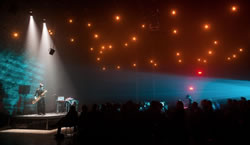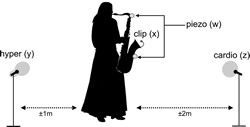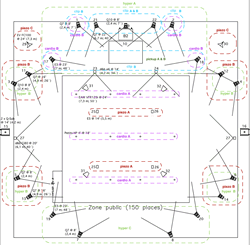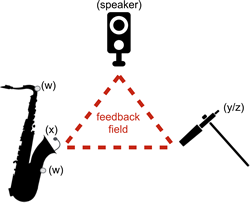Live Sound Spatialization and On-Stage Feedback Control
Cues for the development of interaction between acoustic and electronic musicians
The duo Jane/KIN is formed by an acoustic musician and an electronic musician: Ida Toninato, saxophone player, and Ana Dall’Ara-Majek, laptop musician and spatialist. 1[1. A musician exclusively dedicated to spatialization in the context of a performance (Mooney, Parkinson and Bell 2008).] This specific formation allows the musicians to develop a mixed-music chamber relationship after Gilles Doneux’s definition (2015), which states that the electronic part is played on stage by a musician interacting with one or more other musicians. This chamber music-like relationship enhances the human relationship that exists between the acoustic and the electronic aspects of a project.
Jane/KIN’s research is focused on the different modalities, implications and challenges involved in this type of relationship in the context of a performance with fixed and improvised musical elements. Here we discuss the implications of the specific formation of a saxophone player and a spatialist, and propose two specific strategies of interaction: the live sound spatialization and the onstage feedback control. This is complemented by related observations from each of the participants about the specific project that started this research, Morphine-Vents Sauvages (2015).
Saxophone Player and Spatialist: Implications of a Specific Formation
Within the realm of contemporary practices, it is quite common to see acoustic musicians and electronic musicians performing together in the domain of amplified music. However, the spatialist’s role in live performances is particular because spatial interpretation in this context has its own unique set of limitations.
First, the conventional approach to live spatialization requires fixed-media elements. This implies that the spatialist studies the work’s musical gestures in advance and, with the help of a diffusion console, anticipates and magnifies them during the live performance. When Michel Chion explains that spatialization is about magnifying the internal space of a work, he reminds us that a bad spatial interpretation could destroy the meaning of the work (Chion 1988, 32). Thus, the principle of spatial interpretation includes advance knowledge of events in order to anticipate the manipulations on the diffusion console and to realize adequate spatial dimensions of sounds and adequate spatial figures (Vande Gorne 2002). In the context of a performance including improvisation, an ambiguity could arise in the practice of spatial interpretation (Mooney, Parkinson and Bell 2008). In this case, spatial interpretation enters into the performance more as a result of the performer’s reaction to what is currently happening live than an anticipation of musical events.
Second, the actions of the instrumentalist are part of a clearly defined scenographic and gestural tradition. Musicians know how to indicate cues to other musicians in a context of instrumental chamber music, whereas the spatialist’s cues may not be as evident. Manipulation of a computer keyboard, a controller or a diffusion console does not enter the instrumentalist’s logic of the production of sound and is more difficult to identify by acoustic musicians. Furthermore, the spatialization of the sound is a parameter that is quite difficult to perceive for a musician playing on stage, whose ear will be primarily occupied with the sonic diffusion of the acoustic instrument. Furthermore, the stage is rarely, if ever, positioned in the “sweet spot” of the loudspeaker orchestra. Unless the spatialist opts for exaggerated theatrics (Mooney, Parkinson and Bell 2008), there are new challenges for the acoustic musician who wants to develop a chamber music-like interaction with a spatialist and her sounds diffused in space.
Two Strategies of Interaction in “Morphine-Vents Sauvages”

The Morphine-Vents Sauvages project was Jane/KIN’s first experiment and was premiered in October 2015 at Usine C as part of the Akousma XII festival. Its original goal was to foster an interaction that is more akin to that of chamber music in order to avoid the situation of a musician collaborating with a technician. In this project, two musicians interact with one another. Each is a specialist on her instrument of choice: the saxophone and the loudspeaker orchestra. Morphine-Vents Sauvages is a performance with fixed elements and improvised elements, both composed by the members of Jane/KIN. The saxophonist performs on stage in front of the audience and the spatialist is positioned in the centre of the audience, and the diffusion system surrounds the audience (Fig. 1). The saxophone player is placed inside the diffusion system and has no monitoring system (headphones or onstage monitors) that would help her develop a better perception of the spatialization.
As strategies of interaction, the duo uses live sound spatialization and a technique of onstage feedback control. In the first case, the spatialist’s role is to project the sounds performed live by the saxophone player onto the loudspeaker orchestra. In the second case, the saxophone player uses the microphones and the position of the loudspeakers to create feedback phenomena. Those two strategies allow the musicians to create a real interaction through an exchange in which the spatialist has some degree of control over the acoustic source and the saxophone player has some degree of control over the electrical source.
Live Sound Spatialization
The project was inspired by Stroppa’s ideas about the first version of his work élet… fogytilan (Stroppa 2007, 80), composed between 1989 and 1997. 2[2. The term “életfogytilan” means “life imprisonment” in Hungarian, so Stroppa’s title would translate to Life… imprisonment.] In this work, the clarinet is amplified with eight microphones placed above the instrument’s tone holes, each microphone being assigned to a specific speaker. The projection of the instrument’s acoustic sound therefore changes according to the fingering of the instrument, i.e. depending on which tone holes are open (and “feeding” a mic) or closed at a given moment. The speaker’s projection changes in consequence and gives the impression that the clarinet “was extended to a distance of ten or so meters.” We set out to explore the idea that the natural acoustic projection of an instrument could provide a way to control the distribution of sounds in the loudspeaker orchestra. Consequently, we adapted the system for Morphine-Vents Sauvages with a set of microphones placed at different distances from the saxophone player. After a few tests, we have adopted a set of four types of microphone setups, each having its own specific colouration:
- Close-up. A pair of piezos fixed on the bell and neck of the saxophone (w in Fig. 2).
- Proximity. Clip microphone fixed on the bell of the saxophone (x).
- Medium distance. Hyper-directional microphone at approximately 1 m from the saxophone (y).
- Large distance. Cardioid microphone at approximately 2 m from the saxophone (z).

Each microphone source is monophonic and is assigned to a group of loudspeakers. The spatialist has elaborated the possibility to switch between two or three different groups of speakers during performance. In the speaker assignment schema developed for the premiere, one source — the piezos, for example — could be projected individually or simultaneously over three distinct areas of the loudspeaker orchestra: above the audience (A in Fig. 3), on lateral loudspeakers (B) and on frontal loudspeakers (C). The spatialist’s role during performance is then to choose which group should be activated and to decide which combination of groups would be most effective and appropriate to the moment. All the manipulations are made on a diffusion console on which each fader can control the volume of paired speakers.

The spatialist thus has the ability to amplify specific sounds of the saxophone (i.e. key clicks, breathing, multiphonics, etc.) by cutting non-relevant amplification. The spatialist can also enlarge the sound projection of the instrument, making it into a sort of “extended saxophone”. In this way, the spatialist participates in the elaboration of the work’s musical meaning through the elaboration of a spatial semantic.
Live sound spatialization has the great advantage of making an immediate link between the saxophone player and the spatialist: one is producing sound and the other is modulating its projection. The saxophone player becomes the exciter element inside a larger instrument (the loudspeaker orchestra). In this case, the musician is not in a dialogue with a separate electronic system but is instead an integral part of it. The interaction happens when the spatialist becomes attentive to the saxophone player’s actions in order to react accordingly and, conversely, when the saxophone player chooses to play specific techniques or sounds because of spatial progressions instigated by the spatialist.
From the spatialist’s experience, we could say that the coherence of spatial interpretation depends on spatial dimensions and trajectories, but it also depends on one’s knowledge of which sounds would be effective for a specific type of spatialization. As Mooney, Parkinson and Bell remind us, in a context of improvisation, it could be very difficult for the spatialist to anticipate musical events or musical intentions: “The spatialist has no instructions regarding compositional intent of how a sound should be spatialised” (Mooney, Parkinson and Bell 2008). To avoid this uncertainty, the project was developed and evolved in a context of semi-improvisation containing fixed elements. Thus, the project is divided in four pictures (or parts), each one setting musical rules for the saxophone player and the spatialist. General progressions are pre-defined but local actions are relatively free. In order to maintain control over the project’s timing and duration, a six-track tape is assigned the role of a “road map” that establishes temporal cues for the performance. The elaboration of this road map allowed the duo to safely develop improvised musical propositions while avoiding contradicting musical intentions.
Onstage Feedback Control
The second strategy of interaction used in the Morphine-Vents Sauvages project is the idea of onstage feedback control. As the spatialist modulates acoustic sounds produced by the saxophone player, it seems only fair that she should also have a way to influence the electronic sounds. Following Reich’s idea in Pendulum Music, different types of microphones were used in order to create different strains of feedback, each having its own unique colouration. The phenomenon is generated by creating a feedback field between the saxophone’s close microphones (w, x), the stand-mounted microphones (y, z) and the loudspeakers (Fig. 4).

The amplitude of the feedback can be more or less controlled by playing with the distance between the saxophone’s close microphones and the stand microphones. Different pitch and amplitude of the feedback can also be generated depending on the type of microphone, the microphone’s gain, the saxophone’s key configuration and specific pitches resonating inside the saxophone’s bell.
In spite of our statements about feedback behaviour arising out of continuously evolving empirical experiments, some constants — systemic tendencies and characteristics that are more or less predictable — were nevertheless discovered in our setup. For example, the hyper-directional microphone used for the project (Røde NTG-2) systematically produces a powerful, low-pitched buzz feedback. Also, the cardioid microphone used (Neumann KM84) often produces a high-pitched sinusoid-like sound, very soft, with a variety of pitches mostly depending on the saxophone player’s fingering. These somewhat “fixed” behaviours can be set in opposition to — or played off — the more unpredictable aspects of the system, but are also useful for thematizing and defining musical interactions, and can prove to be useful for the outlining of musical structures and form.
Musically speaking, the feedback generates a second “voice” that allows the saxophone player to create a subtle polyphony that depends on her own position within the performance space, which she changes throughout the performance. Thus, spatial positioning becomes a new parameter in the saxophone player’s technique. Playing with feedback is particularly fascinating because its behaviour is very erratic. The instability of the phenomenon leads us to consider stage microphones as living beings doted with their own temperament. As part of our creative process, we thus included the “mood” of the microphones (sad, shy, tired, angry, grumpy, happy, etc.) as parameters that can influence our musical ideas. Knut Aufermann relevantly compares the phenomenon of using feedback in a musical context to the instinct of an animal: “Anybody can experience what a strange kind of animal feedback is and how small changes to the system can have huge results” (Aufermann 2005, 495).
Observations of the Participants
While experiencing live sound spatialization and onstage feedback control during rehearsals at the Université de Montréal studio and in performance at Usine C, we recorded our observations with the objective of documenting the performance and addressing questions about our interaction, our approach and the system we developed for this project.
The Parallel World of the “Field of Possibilities”
Knowing that the stage would present us with a very different sonic reality than our studio, we decided to work in a laboratory format, exploring as many combinations of our sounds and actions as possible. We set a general structure, with a few elements per section, and extensively explored these elements through a range of activities: improvising, recording, editing, improvising again, talking about it, etc. We prepared for the performance by becoming as familiar as possible with all of the elements chosen for use in Morphine-Vents Sauvages and with different ways of interacting. We already knew that the decisions made in the studio may not be relevant in the concert hall. We thus settled on a field of possibilities that could turn out to be true or not true in the performance — somewhat similar to Hugh Everett III’s many-worlds interpretation. 3[3. A non-deterministic interpretation of quantum physics that allows for the possibility that every single imaginable quantum outcome may have happened or may happen somewhere, although perhaps in an alternate universe that we (currently) can neither see nor measure.] In the studio we worked on one possible approach at a time, creating a field of possibilities. Later, in the concert hall, we freely navigated between all the possibilities we experienced in the studio, trusting our musical instinct and the connection we have between us. The field of possibilities became parallel worlds freely flowing during the concert.
The Saxophonist’s Point of View
When the saxophone joins a powerful immersive sonic system, it becomes a part of a much bigger instrument. In order to have the best experience, I need to feel intimately connected to all of the loudspeakers by knowing what kind of material will be spatialized and where. It allows me to draw a line of energy along which my perception will travel to connect my sound with what’s coming from the sound system. On that matter, it felt discombobulating to be at one extreme of the dome of speakers. That position in space gave me an in-front perception, which is a bit ironic for an immersive performance. Being able to trigger feedbacks makes me feel that I am a part of the sonic set up on a much deeper level than usual, which allows my performance to explore multiple sonic levels and different ways of interacting with my partner at the console: we can exchange sounds when she triggers pre-recorded material, I adapt my way of playing according to the microphones she is spatializing and vice-versa, and the combination of both of our actions creates the feedback. Those three different types of action allows for a very rich interaction between us, creating the feeling that our music is taking shape right in the middle of us.
The Spatialist’s Point of View
The lesson I have learned from this project is to accept the loss of control, mainly because reproducing the actual performance conditions in the rehearsal studio was not an option, so during the process I prepared myself to perform in unknown conditions. My work during the creative process was to make a mental representation of how things are supposed to sound. It is similar to the situation of the orchestral composer who has to imagine how the piece will sound based on a piano reduction, MIDI simulation, orchestration books and experience. I think this mental representation is part of the spatialist’s expertise.
During the rehearsals we were able to build an 8-speaker system that I considered an orchestral reduction. Experiencing the project in its reductive form and its concert form was fascinating because it raised my awareness of three different spaces in our system:
The space of the instrument follows Stroppa’s idea that the instrument has a spatial potential because it has different areas of sound projection. Depending on the saxophone’s fingering, the sound can be emitted from the bell, the lower keyholes or the upper keyholes. Thus, doing a chromatic scale would be doing a kind of micro-spatialization!
The space of the musician involves the musician’s position on stage. Sounds emanating from the instrument are subject to different natural (acoustic) filtering depending on the musician’s orientation in the space (e.g., facing toward or away from the audience), movements, trajectories and distance from the amplification system.
The space of the loudspeaker orchestra refers to the traditional acousmatic situation in which sound is extended to an architectural level and offers a truly immersive experience.
With Morphine-Vents Sauvages I realized that the work of a spatialist is not confined to the space of the loudspeaker orchestra. Interaction with a musician also consists of taking into account the space of the instrument and the space of the musician. I would also like to consider developing those three spaces in the creative process for Jane/KIN’s future works.
Conclusion
Live sound spatialization and onstage feedback control are two cues that Jane/KIN has developed to find their own chamber music-like interaction. Both situations require a combined effort from the two musicians to produce and to diffuse sound. Live sound spatialization allows the saxophone player to be the exciter of a bigger instrument, which at some point will create its own spatial patterns that are then managed by the spatialist. Onstage feedback control is only possible through a combination of the saxophone player’s actions affecting distance, fingering, etc., and the spatialist’s actions affecting microphone gain. By using mainly acoustic sounds in the fixed-media part, the duo was able to create a stronger relationship between the saxophone and the loudspeaker orchestra.
Nevertheless, spatialization remains a parameter that is difficult to perceive. One conceivable solution would be to perform on a circular stage with all the musicians at the centre, surrounded by the audience and the loudspeaker orchestra. This would allow both the musicians to position themselves in the sweet spot and therefore be able to be more attentive to spatial events. Furthermore, the idea of placing the acoustic musician and the electronic musician closer to each other on stage will allow them to develop a more subtle gestural communication in order to enhance the chamber music-like interaction.
Our future orientation regarding this project is to find some way of making the spatial parameter more evident to the musicians. For the saxophone player, we first thought about a tool for visualizing spatial information which could influence the performance. However, we are more willing to develop a feeling of space rather than visual cues. From a musician’s point of view, we think it would be beneficial to practise our own spatial perception, which is similar to the musician’s listening education. The objective is to make the perception inside the loudspeaker orchestra more acute. Obviously, training daily inside this kind of system has its logistic limitations, which is why we are investigating to find effective substitutes (3D simulations, binaural systems, etc.) that will allow us to continue developing our interaction, taking the spatial parameter into account.
Thanks to Jennifer Thiessen for the revision of the text.
Bibliography
Aufermann, Knut. “Feedback and Music: You provide the noise, the order comes by itself.” Kybernetes 34/3–4 (2005).
Chion, Michel. “Les deux espaces de la musique concrète.” Lien I — L’espace du son (1988 [rev. 1998]). Ohain, Belgium: Musiques et Recherches.
Doneux, Gilles. “Les musiques mixtes: un espace d’interactions.” JIM 2015. Proceedings of the 22nd Journées informatiques musicales (Montréal, Canada: Université de Montréal, 7–9 May 2015). http://jim2015.oicrm.org
Mooney, James, Adam Parkinson and Paul Bell. “Sound Spatialisation, Free Improvisation and Ambiguity.” SMC 2008. Proceedings of the 5th Sound and Music Computing Conference (Berlin, Germany: Technische Universität Berlin, 31 July – 3 August 2008). http://smc.afim-asso.org/smc08
Stroppa Marco. “Accorder musicalement un espace réel et un espace inventé.” Rue Descartes 56 (February 2007) “Musique, architecture,” pp. 70–81.
Vande Gorne, Annette. “L’interprétation spatiale. Essai de formalisation méthodologique.” Revue DÉMéter (December 2002). Université de Lille-3.
Social top